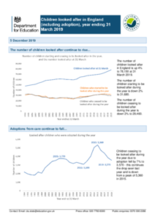Demographic Data
|
Sources: World Bank, UNICEF, UNDP HDR 2015, DHS 2014/2015 |
Displaying 5231 - 5240 of 14348
The purpose of the current consultancy is to review the situation of children with disabilities with special focus on the access and quality of services (especially recovery and rehabilitation services) for children with disabilities and their caregivers, living in their families or in placement in foster care or with other families.
This country care review includes the care related Concluding Observations adopted by the Committee on the Rights of the Child and the Committee on the Rights of Persons with Disabilities.
"Over 30,000 children in Guatemala were adopted internationally decades ago but some have learned they were taken away from their birth families," says this article from NBC News.
The purpose of this study was to investigate the extent to which government allocated financial resources, management procedures and stakeholders are major determinants of implementation of cash transfer program for orphans and vulnerable children in Isiolo County, Kenya.
With an ambition of supporting the design of effective preventive child welfare measures targeting children in out-of-home care (OHC), the overall aim of this thesis is to examine education as a possible intervention path for improving their development and overall life chances.
IWORDS Global has been commissioned by Elevate Children Funders Group (ECFG) to carry out a global research that provides an independent and impartial analysis of the current status of children and youth rights and well-being, philanthropic community and field power balances and imbalances. In the interest of making the study truly participatory and inclusive, they are reaching out to stakeholders engaged in this field, including donors/funders, youth and children's organizations, and community-based organizations to participate in a short survey.
Driven in part by their experiences as members of the Elevate Children Funders Group (ECFG) and funders of child protection programs, and also due to the sector-level momentum generated by the UNGA reviews of the CRC and the Alternative Care Guidelines, UBS-Optimus Foundation and GHR Foundation have agreed to engage a consultant to review monitoring and evaluation frameworks in child protection.
This report reviews information on looked-after children in the UK at both national and local authority levels for the financial year 2018 to 2019.
Through a review of implemented programs to reunite street-involved children and youth (SICY) with their families as well as relevant formative research on family-level risk factors for street migration, the authors of this study explore family-level factors relevant to successful family reintegration of SICY.
The authors of this study conducted qualitative interviews of 69 caregivers in four countries: Ethiopia, Kenya, Cambodia, and India (Hyderabad and Nagaland), and across four religious traditions: Christian (Orthodox, Roman Catholic, and Protestant), Muslim, Buddhist, and Hindu. They asked respondents to describe the importance of religion for their becoming a caregiver, the way in which religion has helped them make sense of why children are orphans, and how religion helps them face the challenges of their occupation.





